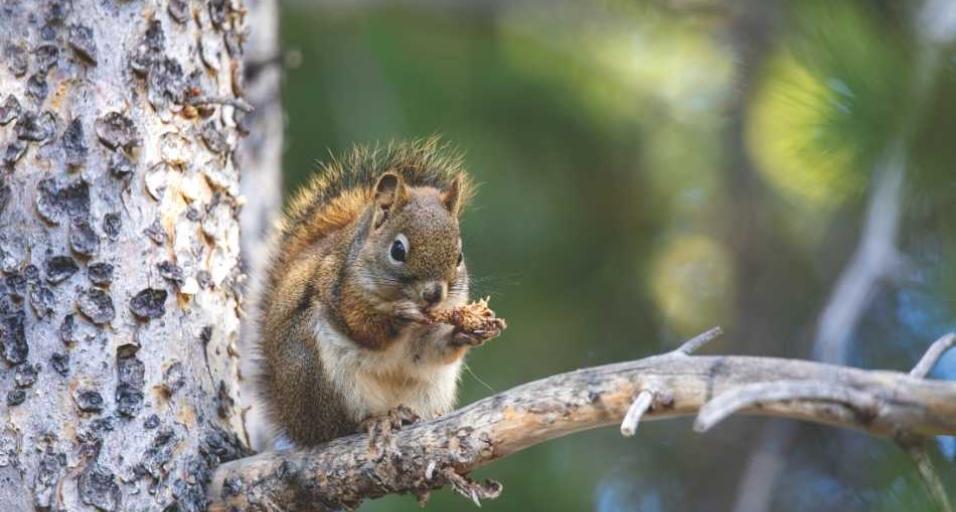An American red squirrel chattered as I searched for a geocache hidden in a remote area of the Snowy Range Mountains in southeast Wyoming. The scolding got louder as I approached a stand of pine trees, and I realized I must be close to the squirrel’s territory and its cache of food.
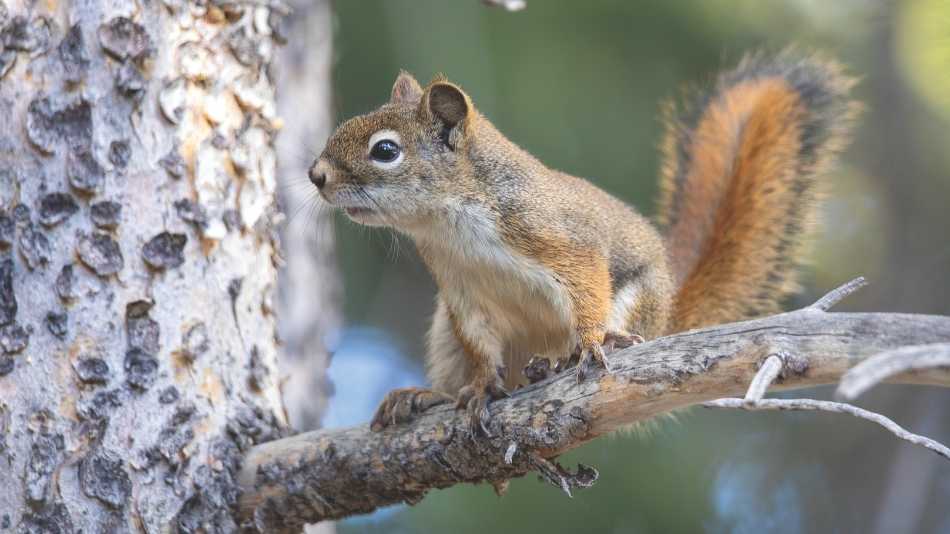
The American red squirrel is found in coniferous forests throughout Wyoming. (Photo by Patrick Owen/WGFD)
I changed direction and headed to some nearby rocks, while pondering the parallels of geocaching — a game of hide-and-seek in which the player locates hidden treasures using GPS technology — and a squirrel’s cache of food. For the squirrel, a food cache isn’t a game. It’s a crucial element for its survival. Wyoming’s tree squirrels remain active year-round and rely on hidden food caches to survive winter. They are literally squirreling it away for the future.
I decide to hide behind a boulder and watch the squirrel through my binoculars. After a few minutes, the chattering stopped and the squirrel climbed down the tree and went back to work. It disappeared into the trees for a minute or two only to reappear with a pinecone in its mouth. Then it scurried back to its original location, disappeared for a minute and reappeared without the cone. Each time it would take the same path across the trunk of a fallen tree, and it was entertaining to watch as it hurdled over broken branches and limbs, determined to overcome any obstacle in its path. The squirrel repeated this process dozens of times, each trip yielding more food.
As the shorter, cooler days of autumn arrive, a tree squirrel’s instincts kick in and it begins to gather and store as much food as possible. Once it gathers food, it stores and protects it from other animals. Some species store it all in one place — in a larder of sorts, no different than the pantry in your kitchen — while others scatter it all around in countless hiding places, similar to an Easter egg hunt. Ground squirrels use a combination of these two methods.
ALL IN
The American red squirrel is the ultimate larder hoarder of Wyoming’s coniferous forests. Also known as the pine squirrel or sometimes the chickaree due to its nonstop chattering, the red squirrel lives in spruce-fir and pine forests throughout the mountainous areas of the state. Its primary food sources are the nuts and seeds from coniferous trees. In late summer and throughout autumn, the red squirrel collects and caches thousands of pinecones to last through winter. A single pinecone can hold numerous seeds, so the squirrel simply caches the entire cone.
Because their survival depends on these caches, red squirrels are territorial and will defend their caches from other squirrels, birds and the occasional geocacher. They’ll chatter, flick their tails, act aggressively and otherwise try to scare the potential thief away from their food.
Constantly gathering and defending food requires a lot of energy, and when the squirrel gets hungry, it will remove a cone from its cache and take it to an elevated perch — usually a tree — to consume it. As it chews through the cone to reach the seeds buried inside, the cone scales fall to the ground and accumulate in a pile known as a midden.
According to the Jackson Hole Wildlife Foundation, a midden is several inches of cone scales and cores heaped over mineral soil, forming mounds up to several feet high and wide. The loose surface often has shallow holes in it. In the mineral soil below, there may be a network of tunnels. Squirrels pack several cones, pointed end down, into holes that will eventually be covered by more scales and cones. In this cool and moist environment — a humidor — cones will remain unopened for at least one to two seasons until the squirrels retrieve them. When they do, squirrels eat cones like corn-on-the-cob, scattering scales everywhere while consuming the nutritious seeds.
A red squirrel’s midden can be found at the center of the most productive group of trees, and the number of cones a tree produces can vary from year to year. Some years are good with an abundance of cones, known as a mast year. A mast year happens every few years for some spruce trees, such as Engelmann spruce, while fir trees have mast years every 4-5 years. Some studies suggest female red squirrels appear able to predict an upcoming mast year and will increase their litter size in anticipation. Other years are leaner, meaning the red squirrel has to work harder to cache enough food for winter. The red squirrel is well adapted to these conditions and can scrape by on almost any conifer seeds that may be available.
There are pros and cons of being a larder hoarder.
Having your entire food source in one place makes it easier to defend. It’s also easier to monitor and access during winter. But there are disadvantages. Having all your eggs in one basket, so to speak, can result in complete loss if the midden is destroyed by a natural disaster such as a fire, or discovered by a food thief.
Hoarding artificially concentrates food, which can attract other hungry animals. In Wyoming’s higher elevations, a red squirrel relies on the nuts from the white-bark pine, a food source also favored by grizzly bears. If a bear discovers a squirrel midden, it will feast on the energy-rich food stored inside while exerting almost none of its own energy. The red squirrel can only watch helplessly, its chattering and threats being ignored while the bear consumes months’ worth of work. Red squirrels also must compete with other species such as the Clark’s nutcracker for pinecones, and these birds are known to raid a squirrel’s midden and hide the stolen cones for their own use. Other squirrels are a constant threat to a midden, and a red squirrel will constantly defend its territory against rival squirrels.
Other animals aren’t the only ones to benefit from a squirrel cache. A midden can alter the surrounding soil structure and the resulting nutrient cycling, which in turn can benefit other organisms. The feisty red squirrel does its part to improve habitats in Wyoming’s high country.
SPREAD IT AROUND
At lower elevations and closer to town, the fox squirrel also caches food for winter, but its method is different from that of the red squirrel. The fox squirrel, which in Wyoming is mainly found in urban areas in the eastern part of the state, is an obligate scatter hoarder.
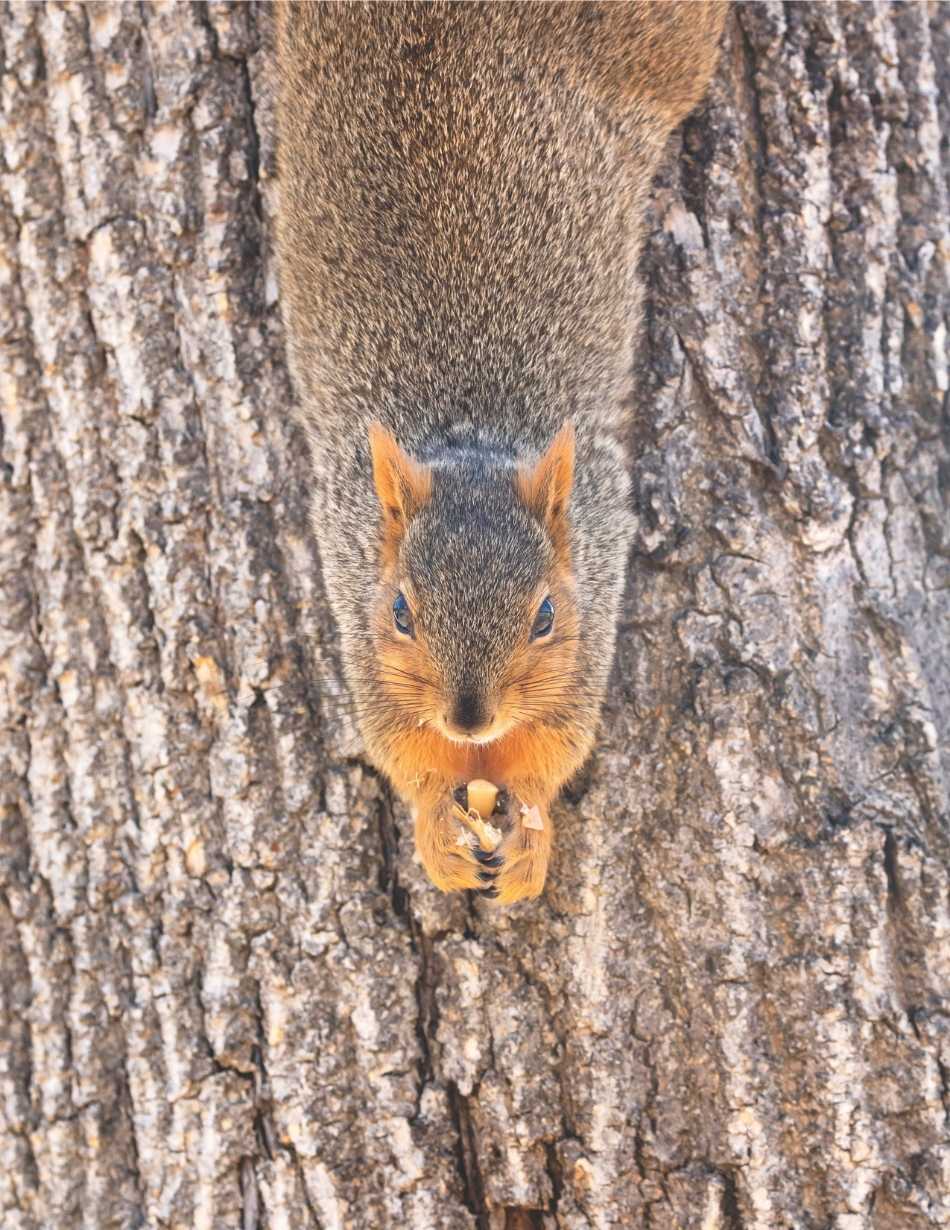
The fox squirrel is an obligate scatter hoarder, which involves caching hundreds or thousands of pieces of food in individual hiding places. (Photo by Vic Schendel)
As the name suggests, scatter hoarding involves caching hundreds or thousands of pieces of food in individual hiding places. A fox squirrel’s diet includes nuts, seeds, fruits, buds, flowers, twigs, bird eggs, roots and fungi. Because these food sources aren’t contained in one place like that of seeds in a pinecone, a fox squirrel will forage over a much larger area compared to a red squirrel. This makes it difficult to guard a single, large stash, so it makes more sense for a fox squirrel to be a scatter hoarder.
Fortunately, there is no shortage of hiding places when you’re a squirrel. Fox squirrels will cache food in a crevice of a tree, under a piece of loose bark or a hole the squirrel digs into the ground. They’ve also been known to cache food in and around human dwellings and buildings. Although this strategy leaves more caches for hungry thieves to find, each cache’s smaller size eliminates the risk that a squirrel will lose its entire food supply.
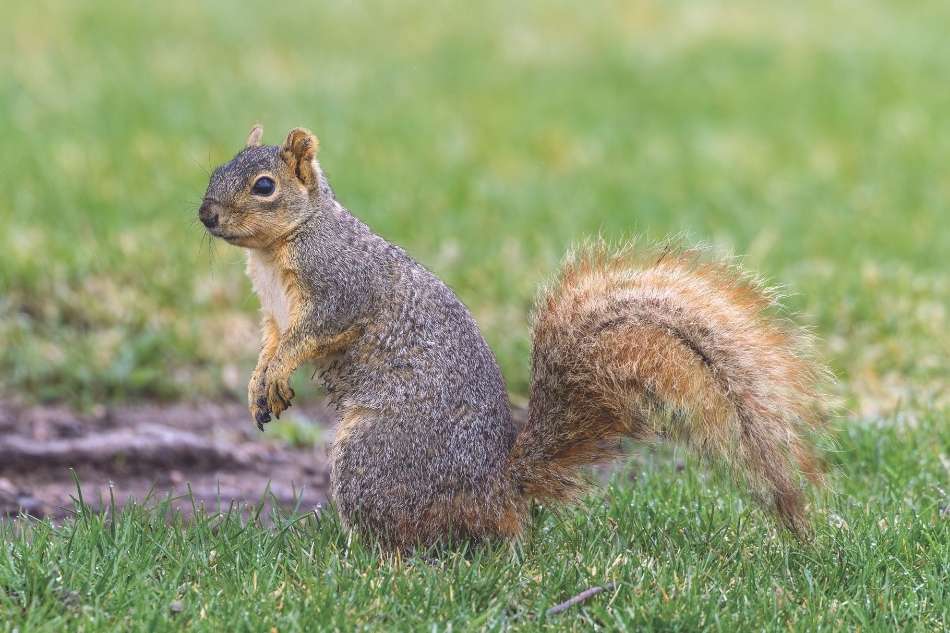
Fox squirrels are found in urban areas in the eastern part of Wyoming. (Photo by Patrick Owen/WGFD)
Weeks or months later, a hungry fox squirrel has to find where it stashed its food. Much like a geocacher, a fox squirrel must search for its hidden caches. But instead of coordinates and a GPS, it must rely on spatial memory, visual clues such as nearby landmarks and an excellent sense of smell. Fox squirrels also use a technique called spatial chunking to help them remember where they've buried their food, often organizing their caches by nut species. All these combined methods help them locate hundreds or thousands of small or individual caches with inconceivable success.
In a scientific study titled, “The socioeconomics of food hoarding in wild squirrels,” published in Current Opinion in Behavioral Sciences, the authors suggest scatter-hoarding squirrels recover nearly 80 percent of their hidden stores.
Forgotten caches are often found by other animals such as birds, chipmunks, mice, raccoons and other squirrels. Many are never found. Unlike those stored in a midden, many nuts and seeds cached by scatter hoarders will germinate when not recovered and eaten. Some will grow into trees, which helps supply future food sources for the squirrels. This is an example of a mutualistic relationship, in which the squirrels help with reforestation, which in turn provides more food for the squirrel.
Another tree squirrel in Wyoming, the eastern gray squirrel, limited to small populations in northeast Wyoming, also is a scatter hoarder. The gray squirrel will pretend to bury a nut or seed in case other squirrels are watching. Like the fox squirrel, gray squirrels have been observed using spatial chunking to organize their caches by seed type, and also rely on memory and an excellent sense of smell to find their caches.
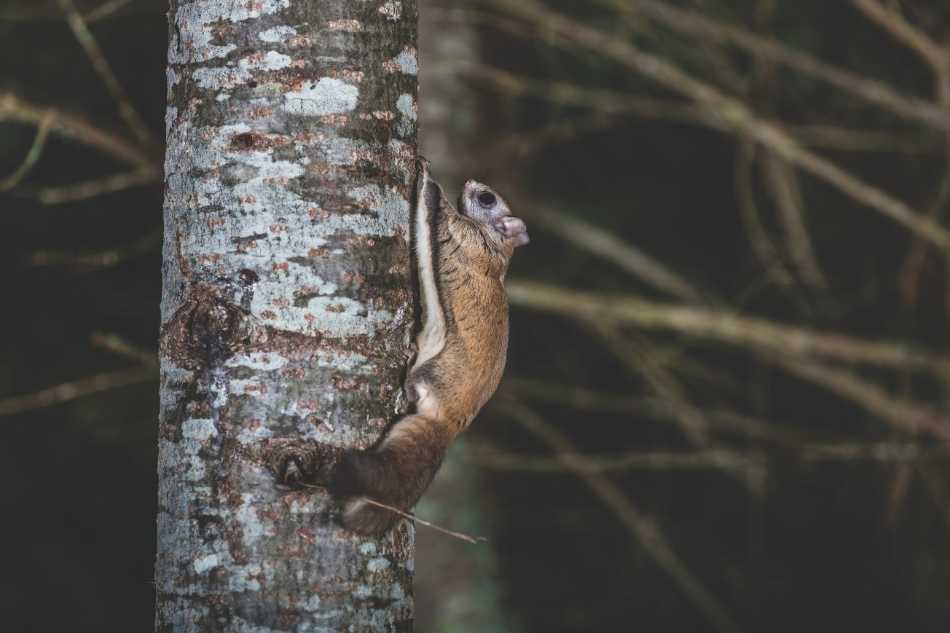
Northern flying squirrels are found in coniferous forests in northwest Wyoming, and also in the Black Hills. (Adobe Stock Photo)
The northern flying squirrel is found primarily in coniferous forests in the mountains in northwest Wyoming, as well as in the Black Hills. While flying squirrels store food for winter, their caching behavior is not as extensive as other tree squirrels. This is because they have year-round access to their primary food sources of lichens and fungi. However, a flying squirrel will cache some nuts, seeds and other items in its den to supplement its winter diet.
Some ground squirrels will gather and store limited amounts of food when times are lean. The thirteen-lined ground squirrel hibernates most of the winter but occasionally caches a few food items. Combining the larder and scatter hoarding methods, it will cache limited amounts of food in its den and around its habitat to feed on during brief periods that it may awaken during hibernation.
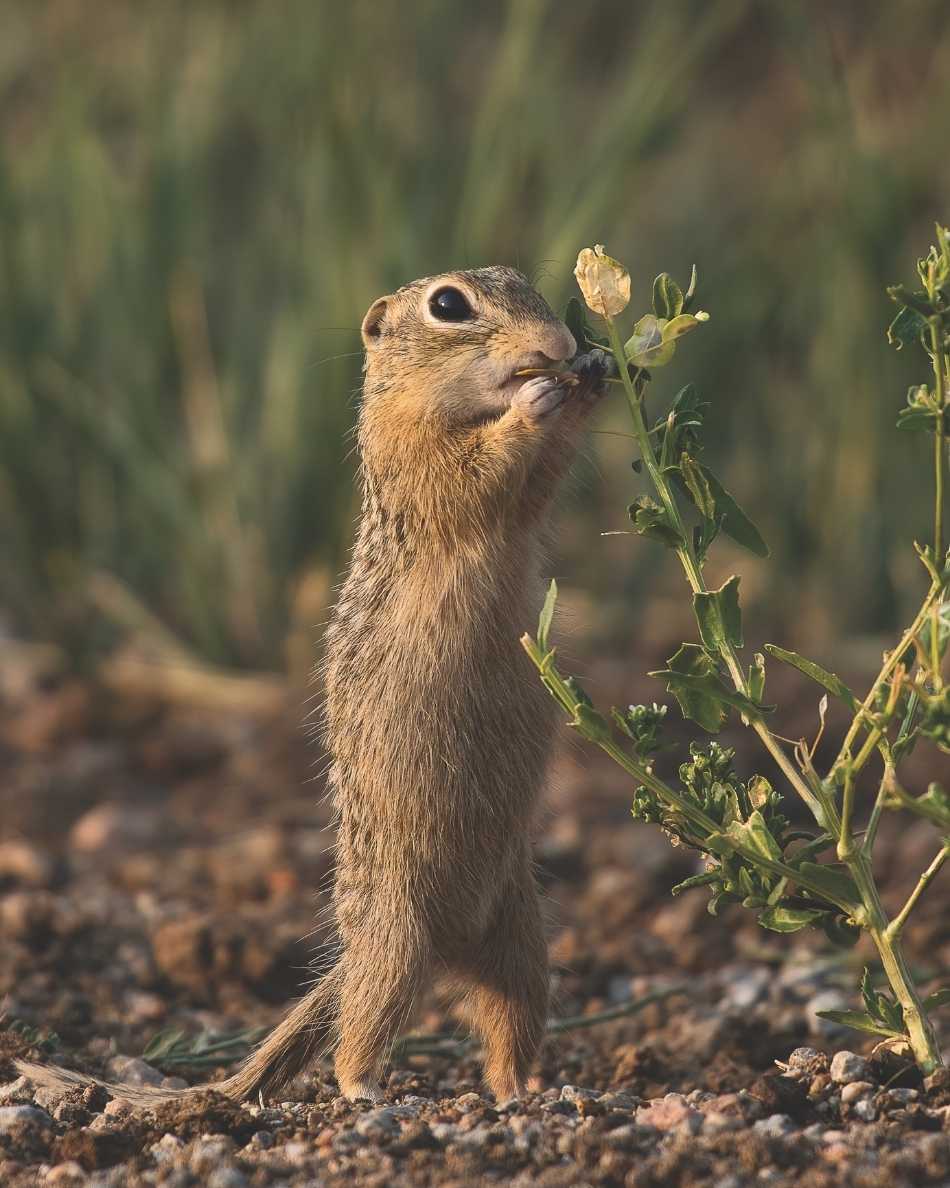
Thirteen-lined ground squirrels hibernate for most of the winter but do cache some food items.
(Photo by Mark Nelson/WGFD)
As the red squirrel continued its search for food, I rose from my hiding place and continued my own search. I finally located the geocache in a rock outcropping not far from the trees. The red squirrel once again scolded me as I admired the hidden treasure I found. Following the rules of the game, I signed the logbook and returned the cache to its hiding place among the rocks. As I retreated from the area, I realized I’d worked up an appetite. The red squirrel’s chattering faded as I started down the trail toward home, where an ample supply of cached food awaits.
— Robin Kepple is a retired Wyoming Game and Fish Department information and education specialist.

